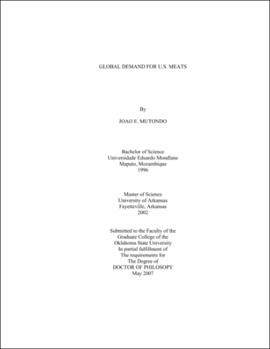| dc.contributor.advisor | Henneberry, Shida Rastegari | |
| dc.contributor.author | Mutondo, Joao E. | |
| dc.date.accessioned | 2013-11-26T08:22:03Z | |
| dc.date.available | 2013-11-26T08:22:03Z | |
| dc.date.issued | 2007-05 | |
| dc.identifier.uri | https://hdl.handle.net/11244/6528 | |
| dc.description.abstract | Scope and Method of Study: This study is composed of three chapters. The first and second chapters assess the competitiveness of U.S. meats in the major U.S. export markets and in the U.S. domestic market, respectively, taking into account the effects of seasonality and animal disease outbreaks (Bovine Spongiform Encephalopathy-BSE and foot-and-mouth disease-FMD). The restricted source differentiated almost ideal demand system (RSDAIDS) is used to estimate Canadian, Japanese, Mexican, South Korean, and U.S. demand models. The objective of the third chapter is to estimate the welfare impacts of beef and pork promotions, country of origin labeling (COOL), and the Japanese and South Korean bans of U.S. beef on producers and marketers of U.S. meats. An equilibrium displacement model is built and used to estimate welfare measures. | |
| dc.description.abstract | Findings and Conclusions: The results of the first chapter show that Japanese beef, Danish pork and Brazilian poultry have the most to gain from an expansion of the Japanese meat market. BSE outbreak in Japan decreased the shares of U.S. and Japanese beef. The results of South Korean demand model indicate that U.S. and Australian beef, Danish pork, and Thai poultry have a competitive advantage. BSE outbreak in the U.S. decreased the shares of U.S. beef. For the Canadian demand model, the results show that U.S. and Canadian beef, and U.S. pork have a competitive advantage. Canadian BSE outbreak decreased the shares of Canadian beef. Regarding Mexican meat demand, the results suggest that an increase in Mexican meat expenditures is expected to increase demand for meats from all sources. Results of the second chapter indicate that U.S. fed beef and Canadian beef, rest-of-the world pork, and U.S. poultry would benefit from an increase in U.S. meat expenditures. The results of the third chapter indicate that beef and pork promotions increases welfare of meat industry with beef and pork benefiting the most. COOL will decrease welfare of beef and pork industries unless accompanied with an increase in demand. Bans on U.S. beef decrease the welfare of producers and marketers of U.S. beef and increase the welfare of producers and marketers of competing beef products. | |
| dc.format | application/pdf | |
| dc.language | en_US | |
| dc.rights | Copyright is held by the author who has granted the Oklahoma State University Library the non-exclusive right to share this material in its institutional repository. Contact Digital Library Services at lib-dls@okstate.edu or 405-744-9161 for the permission policy on the use, reproduction or distribution of this material. | |
| dc.title | Global demand for U.S. meats | |
| dc.contributor.committeeMember | Brorsen, B. Wade | |
| dc.contributor.committeeMember | Peel, Derrell | |
| dc.contributor.committeeMember | Warde, William D. | |
| osu.filename | Mutondo_okstate_0664D_2163.pdf | |
| osu.accesstype | Open Access | |
| dc.type.genre | Dissertation | |
| dc.type.material | Text | |
| thesis.degree.discipline | Agricultural Economics | |
| thesis.degree.grantor | Oklahoma State University | |
